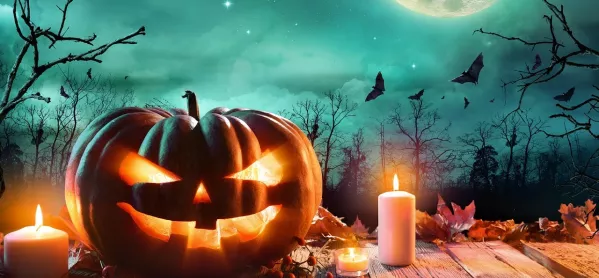- Home
- ‘Halloween horror can get students hooked on books’
‘Halloween horror can get students hooked on books’

Autumn term is a marathon for teachers. Many of us in colleges have been back since mid-August and the height of summer, yet will finish only just in time to drive through winter-dark drizzle and fight supermarket crowds for the last remaining Christmas dinner constituents. This quick breather of the half-term break allows us to look back at how much we’ve already achieved and to look ahead to a further eight weeks where our late-afternoon lessons will feel increasingly like the middle of the night. Nevertheless, this is my favourite term.
The way we approach the English GCSE curriculum for our resit learners is to focus entirely on fiction for this term, so the reading and telling of stories. The stuff that made us want to be English teachers in the first place. The rhythm of autumn also provides some great opportunities for bringing joy to the classroom: the honeymoon period and getting to know your new students in September; the orange-and-black Halloween-themed Powerpoints that nobody can read in October; and then the inexorable winding up to Christmas.
I try to extend Halloween to last from day one of October to somewhere in mid-November. It’s not even that I’m especially into costumes or sweeties, but I do love horror. I think it’s the genre with the widest appeal because it taps into something primal. If you use fantasy, science fiction, or crime texts in your classroom, you always run the risk of alienating some students, but horror seems to be universal. Even those who claim to dislike it mostly just mean that it does too good a job on them. The archetypes and conventions are so simple and well understood that they are unfailingly amusing to spot and to use yourself.
Ghoulish glee
I had a laugh recently, basing some lessons around the classic Point Horror novel Trick or Treat, which scared the bejesus out of me in the early ‘90s. It’s quite naive and dated now; certainly not likely to send the Jigsaw-hardened students of 2018 home with nightmares. But it’s still great fun, thanks to successful tropes such as the first night in a spooky, old house, doors opening and closing on their own, and the midnight, croaky, phone call. Learners know these conventions well and it doesn’t take too much to get them using them effectively in their own writing.
One of my colleagues had the hilarious idea of creating sensory mystery bags as creative-writing prompts. It’s amazing how terrifying a bag of peeled grapes becomes if you ham up your request for a volunteer who has no allergies and no phobias. I might have got slightly carried away, raiding the local pound shop for slime and rubber spiders, sending one of my groups into a state of excitement akin to hyperactive Year 7 pupils on a snow day. For another, lower-confidence group though, the activity provided a breakthrough: smiles where I had only seen anxious frowns before, and laughing descriptions where there had only been an awkward silence.
Having then progressed onto a passage from Shirley Jackson’s The Haunting of Hill House that had even the adult me quaking not too long ago, I was very excited that the timing would coincide with the release of a glossy, new, 10-episode, TV adaptation by Netflix. I couldn’t resist having students compare the trailer for the new series to what they now know of the novel. They came up with some convincing explanations for the multitude of differences too: Having the story focus on a family, rather than four strangers, would “give it more emotional depth” suggested a health and social care learner, whereas an outdoor-ed student explained that child characters had been added because “Kids are creepy. You expect them in horror. Like in The Shining.”
Terribly terrifying
Personally, I was disappointed by the series. Despite my students’ generous justifications for the changes, I felt that abandoning the winning, high-concept formula of the novel added nothing and left the show reliant on predictable jump scares. On the Monday morning after the weekend it aired, I was saying something similar to a fellow English-resit teacher as we waited for our travel and tourism learners to arrive.
One of his students suddenly burst through the classroom door. “I watched it all!” she announced in loud and infectious triumph. She was talking about the Netflix series.
Over the next week, I encountered many other students who had similarly binged it. I know that as an English teacher, my fantasy should be that they went away and read the whole of Shirley Jackson’s novel, but it made me pretty happy that owing to something they’d talked about in English, they’d spent 10 hours of their weekend engaging with something that they were then speaking to their friends about, critically and enthusiastically. Talking about stories is what English is all about. So I’ll relish another long, half term of it.
Andrew Otty leads 16-19 English in an FE college. He is an ambassador for education charity SHINE
Keep reading for just £1 per month
You've reached your limit of free articles this month. Subscribe for £1 per month for three months and get:
- Unlimited access to all Tes magazine content
- Exclusive subscriber-only stories
- Award-winning email newsletters



